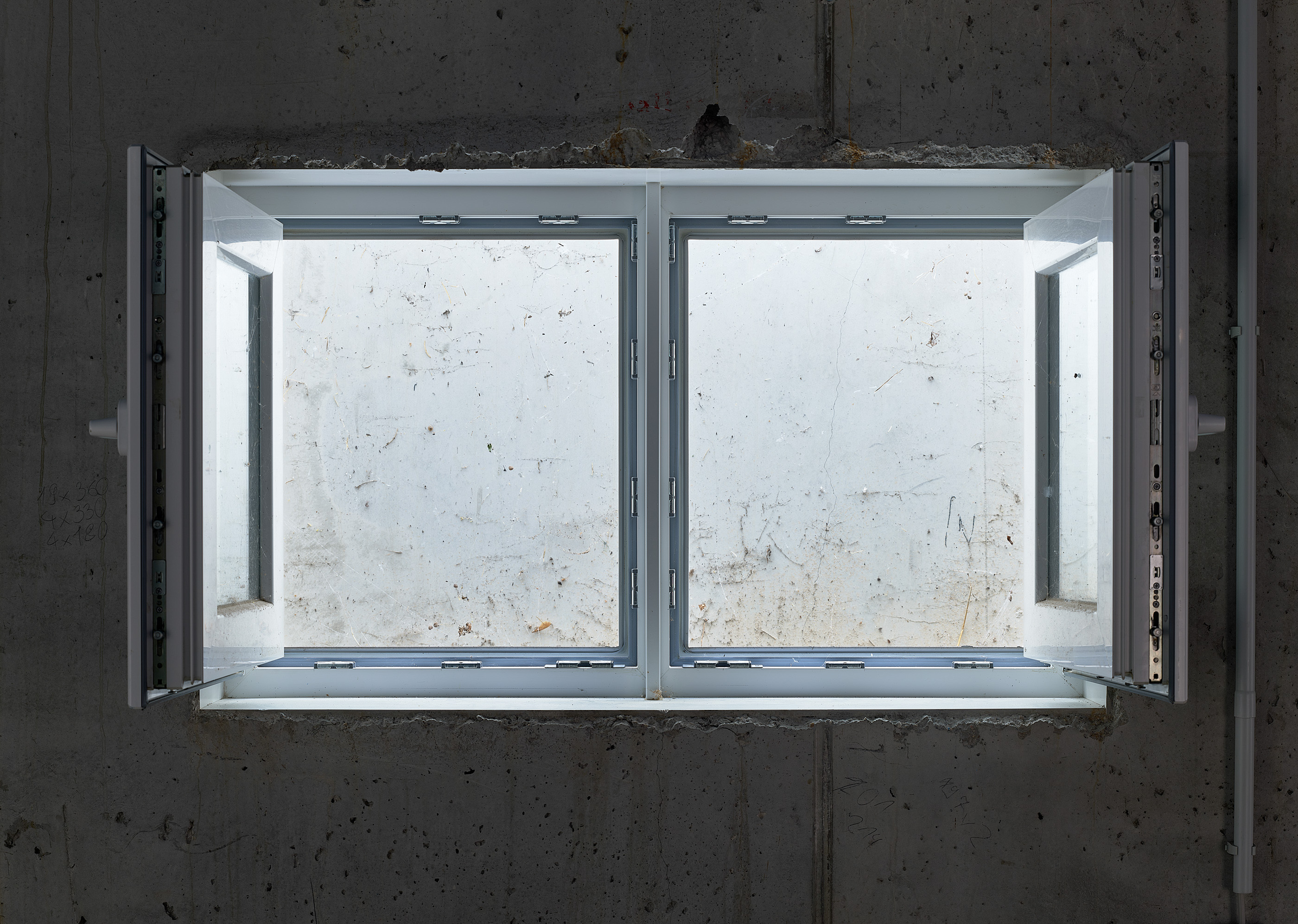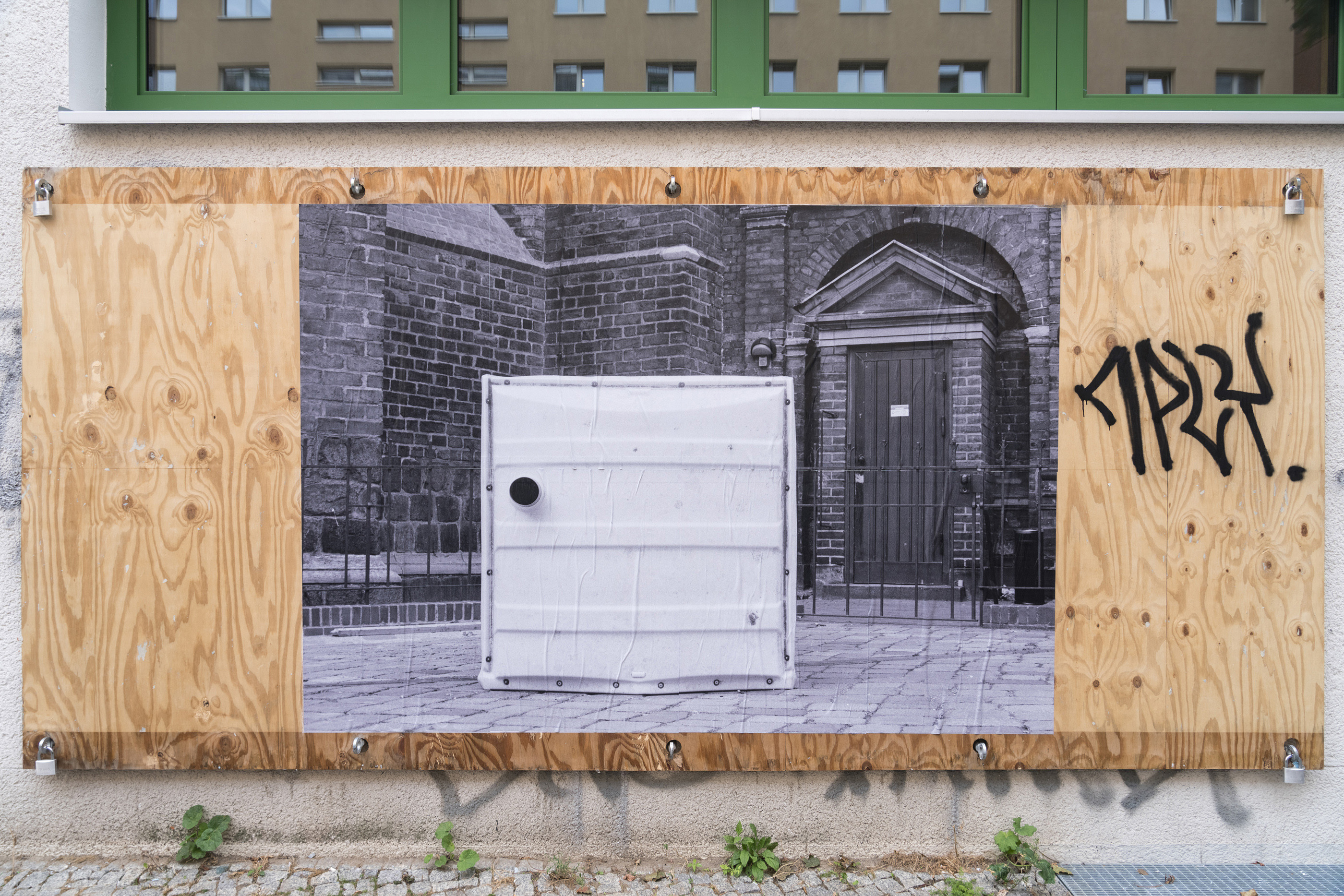THESES ON HOPE #16
Mark Barker: Are you more
with
Ramsay Dyke McClure
Keith Vaughan
12 September–17 November 2024
Opening: Wednesday, 11 September, 6–9 pm

Between Bridges is delighted to present the first survey of the work of British, Berlin-based artist Mark Barker. Conceived around a set of distinct spatial registers, the exhibition highlights Barker’s multi-faceted practice, bringing together works on paper, sculptures and photographs from the last ten years alongside newly conceived works and site-specific installations. Barker’s oeuvre speaks of bodies, how they move and how things move in and out of them. For Are you more, Barker makes use of a wide variety of affective and conceptual approaches as part of a personal exploration of the human condition, understood here as a constant negotiation between order and disorder, slippage and containment.
Barker’s artistic language is rooted in an archive and vocabulary of materials and gestures that have historically been considered ‘minor’, neglected, or abject. Everywhere, through the brokenness and decay of the animate and inanimate – by way of leaks, spills, stains, cracks, smudges, bodily waste and fluids – Barker proposes a worldview that embraces the body as porous and messy, and therefore potentially limitless. These traces and remnants, visible or invisible, are a plethora of resources to be appropriated in order to shift perceptions of the everyday, its public domains, its private sanctuaries, and ultimately the ideologies that shape our environments. Consistent with his emphasis on the body’s ‘emanative’ material constitution, and to further elide the distinction between the organic and the inorganic, Barker abandons the idea of buildings as sealed entities. Instead, he acknowledges architecture as a fluid, at times convoluted system of representations not unlike sculpture, photography or drawing. He explores how the body – socially, discursively, sexually – is produced in space and, in turn, how the body might re-inscribe itself onto its environment – and the traces that such reciprocal transformations produce, both within the body and within architecture.
Consequently, Barker also approaches the architecture of Between Bridges as a leaking, breathing thing, sealing existing perforations in the building’s internal structure and introducing others. Through careful observation of the material and social fabric of the exhibition site, and a precise organisation and distribution of materials, objects and bodies, Barker makes both subtle and substantial interventions into the infrastructure, closing entire rooms and building others. In doing so, he shifts both our physical journey through the space as well as our perception of it. Four distinct areas emerge, with differing modes of composition and display, architectonic and symbolic functions, temperatures and degrees of affective intensity.
On entering the exhibition, Barker has created a threshold, an anteroom in the spatial sense (and a prelude in the narrative one) that speaks of crafting in relation to home- and world-making. In the eponymous installation, Are you more (2024), homes, wasps, ears, flowers and larvae – all made in some part out of bread by Barker are positioned on a protective plastic film used in domestic settings to protect and preserve furniture from stratching and staining. Along the length of both windowsills and arranged in proto-taxonomic order, this work introduces a domesticity and working-class interiority through collecting, as well as the spatialisation and reification of temporality.
Opposite, on the large wall, Barker has placed a photograph by the British artist Keith Vaughan (1912-1977), posthumously dated to the 1930s, hand printed by the artist at the time. Vaughan initially belonged to the Neo-Romantic circle, before turning to painterly abstraction and studies of the male figure, as well as graphics and prints, photography and journal-writing which he kept up throughout his life documenting every aspect of his life, and that was published during the period of full-scale criminalisation of homosexuality. The image of a metal hook placed over a wooden panel occupies a particular place in Vaughan’s oeuvre: it served as the basis for the graphic design of an advertising poster, which he subsequently archived with great care. Known for his distinctive style, Vaughan led a largely private life until 1964, when he acquired a series of dilapidated artists’ cottages called Harrow Hill, in a remote rural area of Essex. Together with his partner, the artist and master cabinet maker Ramsay Dyke McClure (1924-1981), the couple sensitively restored the cottages, and though their relationship has been described as conflictual, Harrow Hill provided them with a quiet, private and safe retreat where they could live together before the partial decriminalisation of homosexuality in Britain in 1967.
While Vaughan, long out of fashion in the art world, has achieved greater recognition in the UK in recent years for his distinctive voice, McClure continues to be overlooked. As part of his homage to the couple, Barker also includes Pink Abstract (1962), a collage by McClure, who provided a sense of domestic stability for his lifelong partner until Vaughan’s suicide in 1977. The collage hung at Harrow Hill throughout the couple’s time there. Barker’s decades-long fascination with the couple and Harrow Hill reverberates through this introduction of the artist couple to audiences outside the UK, and articulates a particular history of intimacy. It speaks of seclusion in the face of the law; of tenderness and care in the context of domesticity; of conflict in the face of their desires; and of how both men were formed and informed as subjects of a restrictive normative ideology.
The main gallery on the ground floor contains works that open up several key strands of Barker’s careful and sensitive research into the experience of living alone in a body, its mechanics and limits. Barker reveals rather than conceals bodily functions, addressing their multiple – ocular, oral, epidermal, genital and anal – entrances and exits. With frequent reference, both tender and mischievous, to the aesthetic strategies of modernist, minimalist and conceptual art, Barker disrupts these traditions through a register of (negative) affects that include guilt, nervousness or fear, and various formations of desire.
Two wall-mounted sculptures constructed in ‘tongue and groove’ replicate the dimensions of the DIXI B by DIXI and the TOI WATER by TOI TOI portable toilet units. ‘Tongue and groove’ is a popular pre-composite wood technique used to join individual pieces together, and its protective, skin-like surface is commonly associated with working-class interiors and aesthetics, also installed by Vaughan and McClure to line the interiors of Harrow Hill cottage. Founded in Essen in 1973, DIXI was the first company in Europe to produce mobile sanitation systems. The company’s own history speaks for its worldwide popularisation, having famously been used during Pope John Paul II’s visit to Germany in 1980. Ten years after DIXI, TOI TOI Sanitärsysteme was founded in Wiesbaden in 1983 and quickly became DIXI’s only serious competitor. In 1997, the two companies merged to become the world market leader. Produced to the exact dimensions of the most popular DIXI and TOI TOI toilets, Dixi (2024) and Toi (2024) are mounted horizontally, in close proximity. Barker has coupled the sculptures with a distance of human scale in between. Toilets of this kind occupy a peculiar position in public space; based on a cultural contract to have rigidly contained areas for bodily needs, the site of urinary and bowel relief is a spatial arrangement for bodies conceived as both container and containment. Unlike those that follow the “laws of urinary segregation”, as Lacan wrote, these public toilets are not gendered per se: they are accessible and ‘democratic’ sites for urinating, defecating and washing that link otherwise potentially unrelated bodies – and yet from a gay male perspective they remain inherently eroticized, either openly or subtly participating in the constitution of desire. Closely related in shape and form to the architectural typologies of the closet, the confessional booth and the glory hole, Barker has cut out a lozenge on each sculpture in the exact position of the original toilet’s air vents, thereby allowing the viewer to peep inside if they wish.
Representations of bodies are positioned throughout the exhibition, many of them equipped with alternative anatomies. Expanded by leakages, their bodily boundaries often display a posture reminiscent of excessively crooked if not broken necks, while others become bodies-as-organs. And yet, in their brokenness and gloom, these bodies inevitably exude a sense of calm and comfort, almost confidence, as they formulate an aesthetic and ethical stance against uprightness. Depicted as individuals, they nonetheless lack an individualistic demeanour, and seem to position themselves between a singular and collective body.
Barker’s earliest work in the exhibition is John (2014). A public water fountain precariously holds on twigs a jam jar wrapped in one of Barker’s socks printed with a detail from Rollie McKenna’s photographic portrait of the artist and illustrator John Minton (1917- 1957). A major figure in the Neo-Romantic movement of the 1940s and early 1950s, Minton felt increasingly marginalised during the rise of artists such as Francis Bacon and Lucian Freud (who was one of his lovers). Renowned for his proud flamboyance in a highly regressive era, and for being both a hyper-magnetic and self-destructive character, Minton – who in the late 1940’s early 50’s lived and worked together with Vaughan – committed suicide at the age of 39, 20 years before Vaughan.
On the lower level, Barker has created an entirely new exhibition space, a corridor-like white cube. This environment is dedicated to a group of works on paper, each depicting a being that adopts the role of weather and its climate lands on its head with a broken neck. While their posture may suggest a state of exhaustion, vulnerability or submissiveness, they seem obnoxious and demand and even enjoy being looked at, radiating an embodied knowledge as if, just before their fall, they had witnessed some new horizon.
The final area is devoted to a site-specific installation that incorporates the latest stage of Barker’s ongoing photographic examinations into the ventilation screens of various types of portable toilets. These screens are positioned above head height, and ‘socially’ designed to provide enough – though certainly not too much – visual and acoustic privacy, and functionally to allow for olfactory release. These intricate, eerie studies of light, colour and texture allow for the aesthetic contemplation of an omnipresent detail that is often unnoticed or outside of our usual field of vision. At the same time, they give expression to what is not seen – or should not be – but which nonetheless makes up the body, from molecules and odours to infrastructures of control and surveillance. The photographic explorations were conceived in dialogue with Barker’s final intervention in the space, the opening of the basement windows, which shifts the ventilation system, temperature and boundaries of the site, as well as offering – for the first time – an unobstructed view of the homemaking habits of the spiders and insects.
The team of Between Bridges and the artist are profoundly grateful for the generous support of Gerard Hastings, Hana Noorali and Lynton Talbot, London.
Curated by Viktor Neumann.
Between Bridges is partner of Berlin Art Week.
As part of Berlin Art Week, please also join us for the event:
On Homemaking
Sunday, 15 September, 5pm
Presentation and artist talk with Mark Barker and art historian and president of The Keith Vaughan Society Gerard Hastings, moderated by writer and art critic Kirsty Bell
Between Bridges
Adalbertstraße 43, 10179 Berlin
Wednesday to Saturday, 12–6pm
Extended Opening hours during Berlin Art Week: 12–15 September, 11am–7pm





































